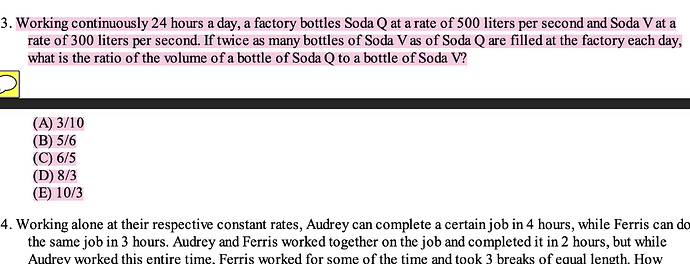Hi,
I want confirmation on this solution as I am not very satisfied with the book’s reasoning. Earlier, I arrived at an answer of 5/6 but I looked again and it said what is the ratio of volumes so is this interpretation correct-
Step 1: Define the variables again
- Let the volume of one bottle of Soda Q be VQ liters.
- Let the volume of one bottle of Soda V be VV liters.
- Bottling rates:
- Soda Q: 500 liters/second
- Soda V: 300 liters/second
- Twice as many bottles of Soda V as Soda Q are filled daily: NV where NQ is the number of Soda Q bottles filled daily, and NV is the number of Soda V bottles filled daily.
Step 2: Relate total volume to the number of bottles
The total volume bottled per day is given by the bottling rates:
- For Soda Q:Total volume=NQ⋅VQ=500 liters/second×86400 seconds/day
- For Soda V:Total volume=NV⋅VV=300 liters/second×86400 seconds/day
Step 3: Use the relationship between
𝑁V and NQ
NV = 2.NQ. (substitute into the total volume equation for Soda V)
After doing all the calculations it would give us 10/3. I saw this solution somewhere btw.
I am not exactly sure if this is the way to go about this. Could you please confirm?
I am still confused because this is asked in ratios so lets say total vol = total number of soda. vol of one
Vol of Q/ Vol of V = y.500 (y being the number of cans) / 2y.300
The answer should be 5/6
Why is this reasoning incorrect?
